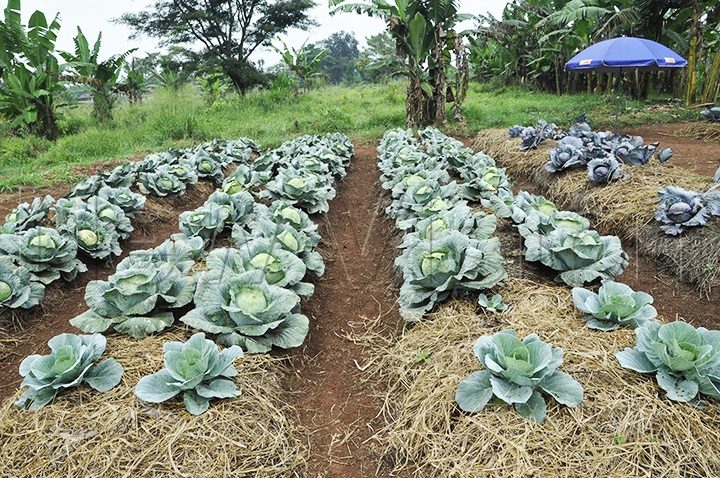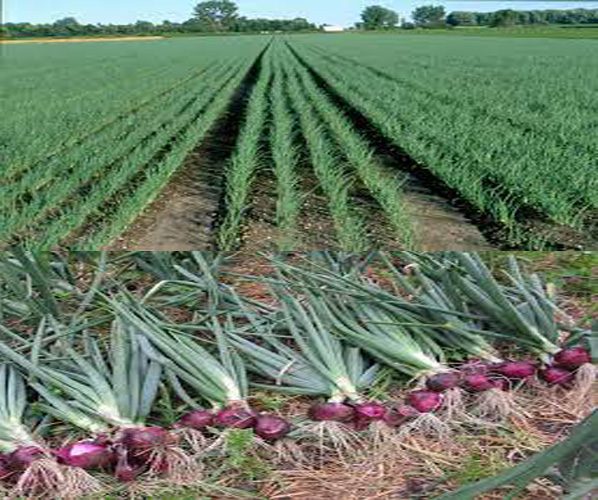Growing vegetables in Uganda is easy because of the climate and soil conditions. Vegetables are one of the most grown agricultural crops in the country because it provides food, income, and employment.
If you are interested to start growing vegetables in Uganda, it will require you to select a suitable location, prepare the soil, vegetable variety selection, plant vegetables, do consistent watering, fertilizing, weed control, disease, and pest control, and harvest.
Interestingly, you can grow vegetables in your backyard or on a large planting site like most Ugandans. If you are willing to grow vegetables in Uganda like other farmers, ensure you follow the steps discussed in this guide to the latter.
How to Grow Vegetables in Uganda
There are numerous vegetable varieties that can be grown successfully in Uganda. You can choose to plant the one that best suit you. Here are the steps on how to grow vegetables in Uganda.
Step 1: Select the Suitable Location
It is important that you select a suitable planting site that meets the requirements to grow vegetables. The soil should be well-drained and with a relatively neutral soil pH. Vegetables prefer a soil pH of 6.5-7.5.
Most vegetable varieties enjoy full sunlight, as such, the site should receive at least 6 hours of direct sunlight each day.
More so, the location should have adequate air circulation to help prevent disease and should be free of weeds, and have adequate levels of organic matter.
The location should not be exposed to excess wind, and importantly, should have a source of water for irrigation, especially during the dry season.
Step 2: Prepare the Soil
If you want your vegetables to grow well, ensure you prepare the soil adequately. There are a couple of soil preparation activities you need to carry out.
You need to start by working the soil so that it is loose and free of weeds and debris of any size.
Before tilling the land, amend the soil using organic matter or the proper fertilizers and amendments for the type of vegetables you will be growing.
Till the soil using simple farm tools such as a hoe, tiller, or garden fork, in the case of large farms, make use of mechanical equipment. Tilling the soil will break the soil to allow for good drainage and root penetration.
Ensure you level the soil using a garden rake to remove any remaining large rocks, roots or other obstructions on the site.
Step 3: Vegetable Variety Selection
There are over 30 vegetable varieties that can be grown in Uganda. You need to select the variety you are interested to grow. You can grow one or more of these varieties on the same farmland.
Also, a select variety that best suit the soil and climate condition of the location, and select varieties that are pest and disease resistant.
Step 4: Planting Vegetables
Vegetables can be planted directly on the farmland either by broadcasting or planting directly into the furrow. You can plant the seedlings in a nursery and then transplant in your garden or farmland.
If you are transplanting the plant, ensure you first plant the seedlings in a nursery or planting pot/tray a month before land preparation.
Ensure you fill the container with the right potting soil and water mildly. The container should contain drainage holes to drain water.
The seeds should be planted 2 inches deep or broadcasted and covered with topsoil lightly. Water immediately after planting, and then place the container in a sunny location. Water regularly daily.
The sprouted plant can then be transferred to the prepared planting site and planted just 3 to 4 inches in the furrow. Water immediately and regularly to keep the soil moist.
If you are planting directly, broadcast or pour the seedlings in the planting hole and cover it with topsoil. ensure your water immediately after planting to keep the soil moist.
Step 5: Consistent Watering
You need to water your vegetable plant regularly to keep the soil moist and help plant get the necessary nutrient. Water twice daily using watering cans or hoses. In the case of large-scale farming, it is best to set up an irrigation system (i.e., drip irrigation).
The soil should be watered deeply but be careful not to overflood the soil to avoid inviting pests and causing plant disease.
Step 6: Fertilizing
Ensure you apply soil supplements to boost soil fertility. Make sure you apply balanced fertilizers such as nitrogen, phosphorus, and potassium to the soil during germination. You can make use of organic matter such as compost, and poultry manure as well.
Step 7: Weed Control
Weeds tend to grow on vegetable farms. In order to reduce weed growth, you employ preventive and control measures. Monitor your farm regularly and quickly remove weeds to prevent competition for nutrients and water.
Weeds can be removed by hand or using simple farm tools such as a hoe or hand trowel. Also, you can employ the use of cultivation and application of pre-emergent herbicides.
Step 8: Disease and Pest Control
Monitor your vegetable plants for disease and pest infestation as vegetables are disposed to be attacked by pests such as aphids, thrips, whiteflies, and caterpillars, among others, and diseases such as bacterial wilt, Alternaria leaf spot, and downy mildew among others.
You can control diseases and pests using fungicides or insecticides. Also, you can make use of cultural methods such as crop rotation, early sowing, and adequate spacing of plants.
Step 9: Harvesting
You can harvest your vegetables when they are ripe and ready according to the instructions on the seed packet or starter plant tag.
Variety of Vegetables in Uganda
Uganda has a wide variety of vegetables that are grown and consumed. Some of the most popular ones include:
- Cabbage
- Tomatoes
- Spinach
- Carrots
- Onions
- Green peppers
- Eggplant
- Sweet potatoes
- Beans
- Peas
How much are Vegetables Sold in Uganda?
The price of vegetables in Uganda varies depending on the type of vegetable and the location of the market. On average, however, a kilogram of vegetables can be sold for about 2,000 to 3,000 Ugandan Shillings (UGX), which is approximately 0.50 to 0.80 USD.
Best Agronomic Practices to engage in Growing Vegetables in Uganda
Some of the best agronomic practices for growing vegetables in Uganda include:
- Soil testing to determine the nutrient levels and pH of the soil before planting
- Using organic manure and compost to improve soil fertility
- Practicing crop rotation to avoid soil-borne diseases and pests
- Using drip irrigation to conserve water and prevent over-watering
- Mulching to conserve moisture in the soil and suppress weed growth
- Using pest-resistant varieties of vegetables to reduce the need for pesticides
- Applying appropriate fertilizers in the right amounts to avoid over-fertilization and nutrient leaching
Projected Profit of Vegetables in Uganda
The projected profit of growing vegetables in Uganda can vary depending on the type of vegetable and the market demand. However, with proper agronomic practices, farmers can expect to earn a profit of between 100,000 to 500,000 UGX (approximately 30 to 150 USD) per acre of land per season.
Common Diseases and Pests of Vegetables
Some common diseases and pests of vegetables in Uganda include:
- Aphids
- Whiteflies
- Cutworms
- Thrips
- Tomato mosaic virus
- Bacterial wilt
- Fusarium wilt
- Downy mildew
Different Propagation Methods of Vegetables
There are several propagation methods for growing vegetables in Uganda, including:
- Seed propagation: Planting seeds directly in the soil or starting them in trays for transplanting later.
- Stem cutting propagation: Cutting a stem from a healthy plant and rooting it in the soil.
- Root cutting propagation: Cutting a root from a healthy plant and planting it in the soil.
- Division propagation: Separating a clump of roots from a healthy plant and planting it in the soil.
Vegetable Growing In Uganda Pdf
Vegetable growing in Uganda is a lucrative business due to the abundance of land, low labor costs, and favorable climate. Uganda’s soils are rich and well-drained, providing a good base for vegetable production.
The country has a wide variety of vegetables that can be grown, including tomatoes, onions, cabbage, carrots, eggplant, and more. Growers have access to improved seeds, fertilizers, and other inputs, as well as support from government and non-governmental organizations.
With proper planning and management, vegetable production can be a profitable endeavor in Uganda.
Growing Nakati On An Acre In Uganda
Nakati is an important crop in Uganda that can be grown on an acre of land. It requires fertile soil, adequate water, and ample sunshine.
Farmers should prepare the soil prior to planting, apply fertilisers, and use appropriate irrigation techniques. Appropriate post-harvest handling, pest and disease control, and timely harvesting should also be observed for a successful crop.
Bugga Growing In Uganda
Bugga Growing is a Ugandan-based agribusiness that provides small-scale farmers with access to the necessary resources and knowledge to grow, process, and market their products sustainably.
The company provides smallholder farmers with agricultural inputs, agronomic training, and access to emerging markets. Through its innovative and sustainable approaches, Bugga Growing aims to improve the lives of smallholder farmers in Uganda and beyond.
Crop with Highest Profit Per Acre In Uganda
Uganda’s highest-profit crop per acre is coffee. Coffee generates an average of $2,000 per acre, making it the most profitable crop in the country. Other lucrative crops include maize, groundnuts, beans, and sunflower.
Most Marketable Vegetables In Uganda
Uganda’s most marketable vegetables include tomatoes, cabbages, onions, eggplants, peppers, and carrots. These vegetables are widely grown in the country and are available in local markets, supermarkets, and grocery stores.
They are also exported to neighboring countries. Other common vegetables include green beans, sweet potatoes, and okra.
Starting A Vegetable Garden
Starting a vegetable garden is a great way to save money, enjoy fresh produce, and get exercise. To begin, choose a spot with good soil, plenty of sunlight, and easy access to water. Remove any existing weeds or debris, and add compost and fertilizer. Consider the spacing of plants when planting and provide support for taller vegetables. Water regularly, keep weeds under control, and inspect plants regularly for pests.
Green Vegetables In Uganda
Green vegetables are an important part of the Ugandan diet, providing essential vitamins and minerals for good health. Common green vegetables include spinach, kale, collard greens, and cabbage, as well as green beans, peas, and okra.
These vegetables are often cooked in a variety of ways, including boiling, steaming, and stir-frying. Green vegetables are a major component of traditional Ugandan dishes, such as matoke, a dish of mashed green plantains.
Green Leafy Vegetables In Uganda
Green leafy vegetables are an important part of the Ugandan diet. They are rich in vitamins and minerals and provide essential nutrients for a healthy diet. Popular varieties include amaranth, spider plant, and cassava leaves. They are often boiled, steamed, or stir-fried, and are eaten as a side dish or as part of a main meal.
How To Grow Vegetables In Uganda
1. Choose The Right Location
Pick a spot in your yard or garden that receives good sunlight and has well-draining soil.
2. Prepare The Soil
Add organic matter such as compost to the soil and mix it in to create a nutrient-rich environment for your vegetables.
3. Plant Your Vegetables
Plant according to the instructions on the seed packet and consider succession planting to make the most of the growing season.
4. Watering And Fertilizing
Make sure to water your vegetables regularly and use a liquid fertilizer every few weeks to provide them with the nutrients they need.
5. Pest Control
Monitor your garden for pests and take action if necessary.
6. Harvesting
Harvest your vegetables when they are ripe.
Best Vegetables To Grow In Uganda
Uganda’s climate is ideal for growing a variety of vegetables, including tomatoes, eggplants, onions, green beans, carrots, kale, cabbage, peppers, sweet potatoes, spinach, and okra. The country also produces a variety of leafy greens such as amaranth, watercress, and collard greens. Root vegetables like cassava, yams, and sweet potatoes are also popular.
Fast Growing Vegetables In Uganda
Uganda is home to a variety of fast-growing vegetables, including squash, pumpkin, sweet potato, cassava, amaranth, and okra. These vegetables are easy to cultivate and can be harvested in a short amount of time. They are rich in nutrients and play an important role in the country’s food security.
Growing Carrots In Uganda
Carrots can be grown in Uganda in well-drained, loamy soils with a pH of 6.5–7.5 and good organic matter.
They need full sun and at least 1 inch of water per week. The soil should be prepared before sowing by incorporating compost and fertilizer.
Seedlings should be spaced about 2–4 inches apart and thinned to 4–6 inches apart when they are 2–3 inches tall. Harvest when the carrots reach a usable size.
Conclusion
Growing vegetables in Uganda is a great way to produce healthy, nutritious food while also providing a sustainable source of income. To do this successfully, good soil preparation, effective pest and disease control, use of water-efficient irrigation systems, and proper crop rotation should be employed.




